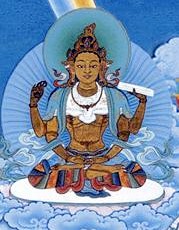Heart Sutra: Difference between revisions
No edit summary |
|||
| Line 49: | Line 49: | ||
*{{LH|words-of-the-buddha/heart-sutra-with-extras|The Heart Sutra with additional prayers}} | *{{LH|words-of-the-buddha/heart-sutra-with-extras|The Heart Sutra with additional prayers}} | ||
*Edward Conze, ''The Short Prajnaparamita Texts'', London: Luzac & Co, 1973 | *Edward Conze, ''The Short Prajnaparamita Texts'', London: Luzac & Co, 1973 | ||
*{{84000|https://read.84000.co/translation/toh21.html| The Heart of the Perfection of Wisdom, the Blessed Mother}} | |||
==Famous Quotations== | ==Famous Quotations== | ||
Revision as of 10:36, 2 June 2022

Heart Sutra (Skt. prajñāpāramitā hṛdaya; Tib. ཤེས་རབ་ཀྱི་ཕ་རོལ་ཏུ་ཕྱིན་པའི་སྙིང་པོ་, Wyl. shes rab kyi pha rol tu phyin pa'i snying po), aka The Twenty-Five Verses on the Perfection of Wisdom — the most popular sutra of the prajñaparamita collection and indeed of the Mahayana as a whole. Although the sutra primarily consists of a dialogue between Shariputra and the great bodhisattva Avalokiteshvara, their words are inspired by the blessings of the Buddha, who remains absorbed in samadhi meditation until the end of the discussion. As with all the prajñaparamita sutras, the teaching took place at Vulture's Peak near Rajagriha.
Related to the Five Paths
In the various commentaries, there are different explanations as to how the sutra can be related to the five paths.
Mantra
The sutra includes the mantra tadyatha om gate gate paragate parasamgate bodhi svaha (tadyathā oṃ gate gate pāragate pārasaṃgate bodhi svāhā). Atisha explained that the mantra encapsulates the entire teaching of the Heart Sutra for the benefit of those of the sharpest faculties.[1]
Dokpa
The Heart Sutra is often recited together with a supplemental section for dokpa, the practice of averting harm and negativity. The text of the dokpa section refers to an incident recounted in the Perfection of Wisdom Sutra in Eight Thousand Lines and Perfection of Wisdom Sutra in Eighteen Thousand Lines, when the god Indra turned away Mara and his forces, who were approaching the Buddha, by contemplating and reciting the Prajnaparamita.[2]
Text
The Hear Sutra was first translated into Tibetan by Vimalamitra and Rinchen Dé. The translation was later revised by Gewé Lodrö, Namkha and others.
Commentaries
Indian
- Atisha,
- Jñanamitra, Prajñāpāramitāhṛdayavyākhyā ('phags pa shes rab kyi pha rol tu phyin pa'i snying po'i rnam par bshad pa)
- Kamalashila,
- Mahajana, Prajñāpāramitāhṛdārthaparijñāna (shes rab kyi pha rol tu phyin pa'i snying po'i don yongs su shes pa)
- Prashastrasena, Prajñāpāramitāhṛdayaṭīkā ('phags pa shes rab kyi pha rol tu phyin pa'i snying po rgya cher 'grel pa)
- Shri Singha,
- Vajrapani, Prajñāpāramitāhṛdārthapradīpa (bcom ldan 'das ma shes rab kyi pha rol tu phyin pa'i snying po'i 'grel pa don gyi sgron ma)
- Vimalamitra, Prajñāpāramitāhṛdayaṭīkā ('phags pa shes rab kyi pha rol tu phyin pa'i snying po rgya cher bshad pa)
Tibetan
- Gungthang Tenpé Drönmé, shes rab snying po'i sngags kyi rnam bshad sbas don gsal ba sgron me
- Jamyang Gawé Lodrö
- Ngawang Tendar, Light of the Jewel (shes rab snying po'i 'grel pa don gsal nor bu'i 'od)
- Taranatha, Word Commentary (Tib. ཤེར་སྙིང་གི་ཚིག་འགྲེལ་, sher snying gi tshig 'grel)
- Rongtön Sheja Kunrig, Clearly Illuminating Mother, Commentary on the Perfection of the Wisdom Sutra (Tib. ཤེས་རབ་སྙིང་པོའི་རྣམ་བཤད་ཡུམ་དོན་རབ་གསལ་ཞེས་བྱ་བ་བཞུགས་སོ།, shes rab snying po'i rnam bshad yum don rab gsal zhes bya ba bzhugs so)
English
- Bokar Rinpoche, Profound Wisdom of the Heart Sutra: And Other Teachings (Clear Point Press, 2002). In French: Le Soutra du Coeur (Editions Claire Lumière, 1999)
- Chögyam Trungpa, Cutting Through Spiritual Materialism, (Boulder & London: Shambhala, 1973) chapter 'Shunyata', pages 187-206.
- Dalai Lama, Essence of the Heart Sutra (Boston: Wisdom Publications, 2002), includes a commentary by Jamyang Gawé Lodrö (1429-1503).
- Garchen Rinpoche, Oral Commentaries on the Heart Sutra in Relation to Shamatha and Vipassana Meditation And Seven Point Mind Training, San Francisco 2001 (San Francisco, Ratna Shri Sangha).
- Rabten, Geshe, Echoes of Voidness (Boston: Wisdom Publications, 1983)
- Sonam Rinchen, Geshe, The Heart Sutra, translated and edited by Ruth Sonam (Ithaca: Snow Lion, 2003)
- Thich Nhat Hanh, The Heart of Understanding: Commentaries on the Prajnaparamita Heart Sutra (Berkeley: Parallax Press, 1988, 2009)
- Khenpo Palden Sherab Rinpoche, Ceasless Echoes of the Great Silence, a Commentary on the Heart Sutra. Translated by Khenpo Tsewang Dongyal Rinpoche. Published by Sky Dancer Press.
Translations
 The Heart of the Transcendent Perfection of Wisdom
The Heart of the Transcendent Perfection of Wisdom The Heart Sutra with additional prayers
The Heart Sutra with additional prayers- Edward Conze, The Short Prajnaparamita Texts, London: Luzac & Co, 1973
 The Heart of the Perfection of Wisdom, the Blessed Mother
The Heart of the Perfection of Wisdom, the Blessed Mother
Famous Quotations
གཟུགས་ལས་སྟོང་པ་ཉིད་གཞན་མ་ཡིན།
Form is emptiness; emptiness also is form.
Emptiness is no other than form,
Form is no other than emptiness.
Notes
Teachings on the Heart Sutra Given to the Rigpa Sangha
- Dzongsar Khyentse Rinpoche, Rigpa London, 19 October 1991
- Sogyal Rinpoche, Lerab Ling, April-May 1998
- Dzogchen Rinpoche, Lerab Ling, July 1998
- Dzigar Kongtrul Rinpoche, using a commentary by Taranatha, Lerab Ling, 8-10 June 2010
- Sogyal Rinpoche, Haileybury, UK, 25 April 2011
- Khenpo Tsering Tashi, Rigpa Australia National Centre, Sydney, Australia, 27-29 January 2022
Further Reading
English
- Conze, Edward. The Prajñāpāramitā Literature (1960)
- Eckel, Malcolm David, "Indian Commentaries on the Heart Sutra: The Politics of Interpretation" in Journal of the International Association of Buddhist Studies, vol. 10, no. 2 (1987), pp. 69-79.
- Lopez, Donald S. The Heart Sutra Explained: Indian and Tibetan Commentaries, Abany: SUNY, 1988
- Lopez, Donald S. "Inscribing the Bodhisattva's Speech: On the "Heart Sutra's" Mantra" in History of Religions, Vol. 29, No. 4. (May, 1990), pp. 351-372
- Lopez, Donald S. Elaborations on Emptiness: Uses of the Heart Sūtra. Princeton University Press, 1996
- Silk, Jonathan. The Heart Sūtra in Tibetan: A Critical Edition of the Two Recensions Contained in the Kanjur, Arbeitskreis für Tibetische und Buddhistische Studien, Universitāt Wien (Vienna 1994).